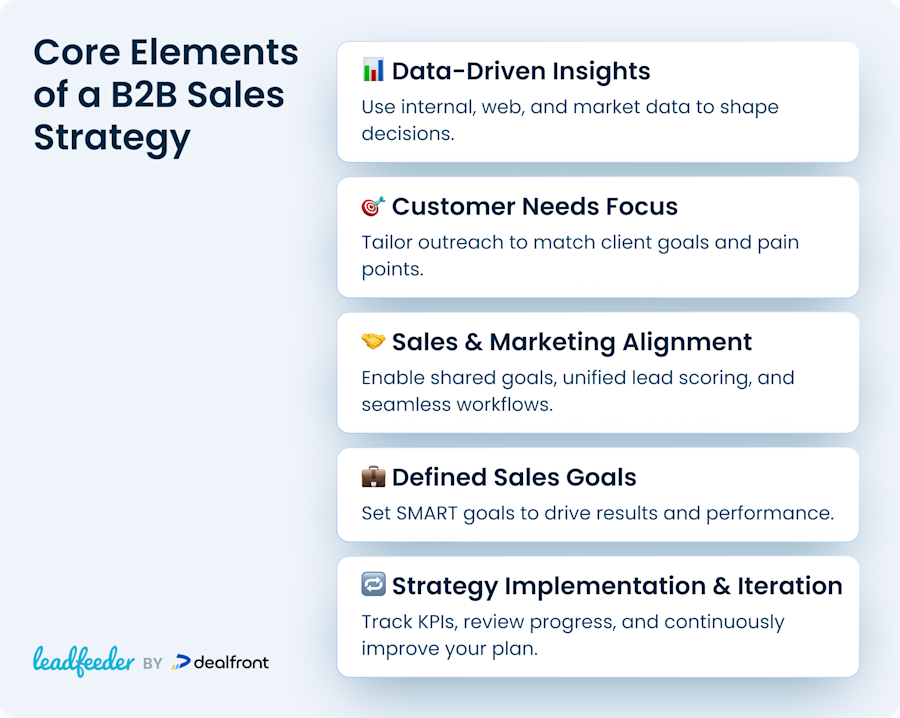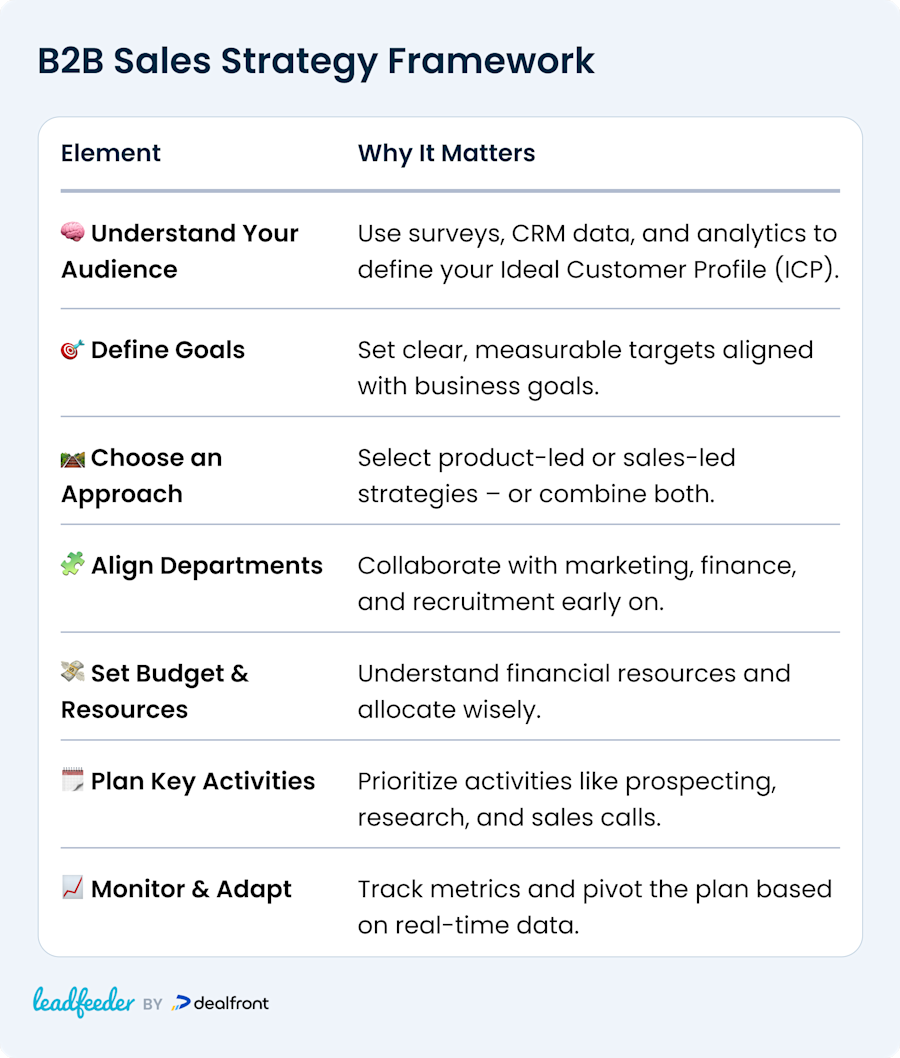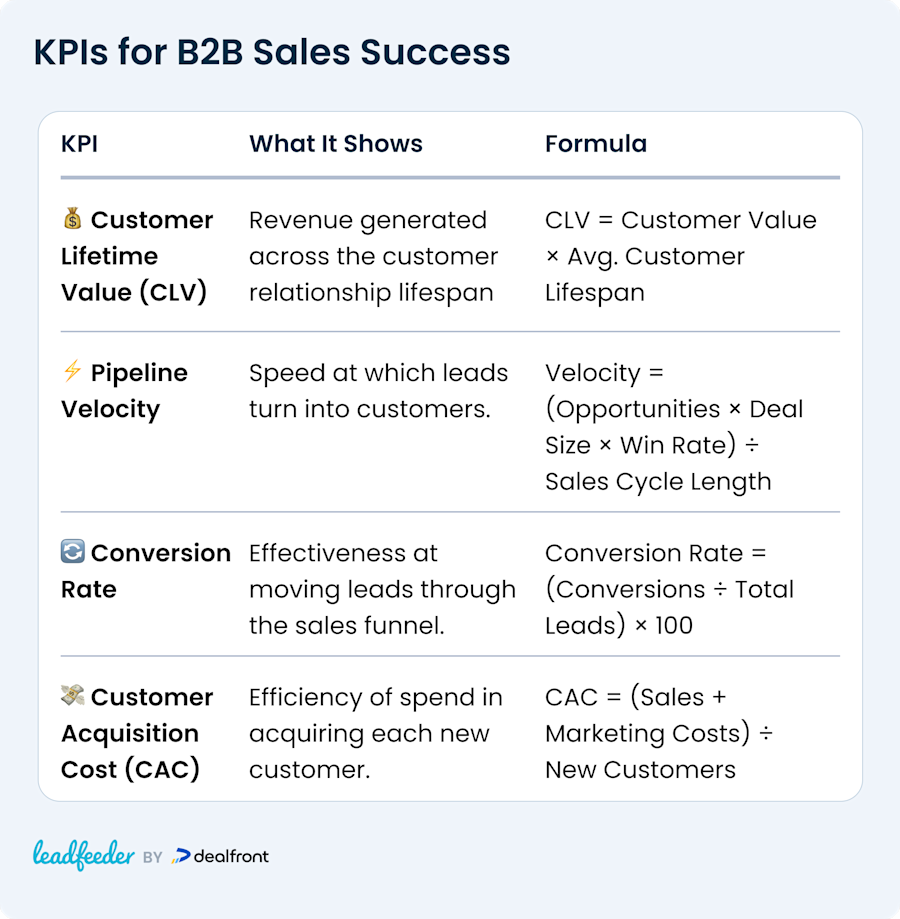There’s never been a better time for B2B businesses to succeed. According to GlobeNewswire, the B2B E-Commerce Market alone was valued at $19.34 trillion in 2024 and is expected to reach $47.54 trillion by 2030, rising at a compound annual growth rate (CAGR) of 16.17%. x
To tap into this opportunity, you’ll need a clear, well-documented B2B sales strategy.
If you’re unsure where to start, don’t worry—this article will give you all the answers you need, from what a general sales strategy is to specific strategies to increase B2B sales.
Let’s dive in.
What is a B2B sales strategy?
A B2B sales strategy outlines your approach to selling your product or service to other businesses. B2B sales can be a complex, multilayered process. That’s why having a thorough strategy is crucial.
What is B2B sales?
Let’s begin by defining what B2B sales is.
B2B (business-to-business) sales involve persuading other businesses to invest in your offering. To accomplish this, sales teams nurture lead relationships throughout the pipeline. They’ll conduct meetings, offer presentations and product demos, and negotiate with clients. Successful B2B cycles can take time and shouldn’t be rushed.
Some of the common traits of B2B sales include:
More stakeholders: B2B sales often involve negotiating with multiple high-ranking decision-makers within an organization. Each stakeholder has different pain points and goals to be accounted for.
Higher pricing: B2B products serve entire organizations and are often much more highly priced than B2C items.
Recurring contracts: Alongside a higher base pricing, B2B products are usually purchased on a subscription basis. Organizations often opt for longer contracts to reduce costs (Switching solutions is often also a lengthy and time-consuming procedure).
What is a sales strategy?
B2B sales strategies outline exactly how you’ll move leads through the different stages of the sales funnel. This is different from a B2C strategy (business-to-consumer), which usually revolves around a fast-paced approach to chasing individual customers.
As established, B2B strategies follow a more long-winded process, involving several meetings with multiple stakeholders. You’ll need a strong knowledge of customer pain points, the current market, and the wider competitive landscape. That’s why the best sales strategies rely on high-quality data.
By building detailed B2B buyer personas, you’ll know your target businesses, the sorts of people they employ, and how best to appeal to them. You’ll collect data from each sales cycle to understand your successes and failures.
You can use historical data to better predict and prepare for new market trends that might inform future buyer behaviors.
Why do you need a B2B sales strategy?
There are many reasons that a B2B sales strategy plan is invaluable. Implementing an effective B2B sales strategy ensures that your approach is data-driven, customer-centric, and aligned with your overall business goals. This allows you to close more deals and increase revenue.
Let’s explore some of the essential elements of a successful B2B sales strategy.

Embrace a data-driven approach
Data is an essential commodity, whether you run a B2B or B2C business. Put simply, it's the best way to understand who your target audience is and what they want. You’ll generate more sales leads and close more deals.
Part of building a comprehensive strategy is gathering data-driven insights. You’ll collect information about your target audience, competitors, and the effects of different tactics. For a diverse, in-depth dataset, you’ll compile insights from varied sources, including:
Your company website
Internal data
Market research
Interviews and focus groups
External third-party sources
Embracing a data-driven approach sets a standard for other departments to follow. When marketing, HR, and others follow your lead, you benefit from a more efficient process and get quicker results.
Satisfy customer needs
Modern B2B customers are accustomed to certain levels of service. They expect you to know their business, its wider aims, and their specific goals. Crucially, they want you to tailor their experience around these factors.
Personalization leaves a clear mark on the buying journey. The 2024 Digital Engagement Benchmarks Report by ON24 showed that engagement with calls-to-action increased by nearly 70% year on year, while requests for product demonstrations grew by four times, and conversion rates doubled for personalized experiences.
A clearly planned strategy helps you obtain the depth of audience knowledge you need to offer personalization. You’ll have a clearer idea of the different stakeholders that make up your audience and the kinds of experiences they expect.
Align sales and marketing
Sales and marketing are two spokes of the same wheel. Without a steady stream of leads from the marketing department, the sales team won’t have a clear list of prospects to pursue. Without sales, the efforts of the marketing team would be for nothing.
To get the most out of these teams, you must align sales and marketing. That means working toward a common objective and sharing data to aid both departments. Too often, however, communication between these teams breaks down. Progress is slowed, and it's harder for both teams to get the results they need.
Every good sales strategy should involve the marketing department. Together, you can work to answer crucial questions, such as:
What communication methods can ensure clear dialogue between departments?
How can you ensure a single source of data that flows between teams?
What criteria should both departments use for scoring and qualifying leads?
By answering these questions ahead of time, you guarantee clear alignment from day one.
B2B sales strategy examples
There’s no denying that a B2B sales strategy is important. But how can a plan help a B2B business succeed? Here are some examples of strategies to increase B2B sales utilized by different businesses:
Software as a Service (SaaS) companies
SaaS sales seeks to attract and retain new clients by delivering value and fostering long-term relationships. Part of their strategy will involve creating a playbook filled with sales tactics and materials. This might include some of the following:
Sales scripts
Content marketing materials
Email templates
Sales collateral (content designed to educate customers as they move through the sales process)
Relevant industry information and insights about competitors
Manufacturers
A manufacturing sales strategy must consider the entire sales process, including the production of items, customer needs, and the wider market demand. A thorough manufacturing strategy should clarify the following areas:
Steps to establish long-term relationships with clients
Business leaders to network with
Promotions and offers to pull in different sorts of customers
Market research to help optimize supply chains
Distributors
Distribution companies seek to boost sales by improving performance and establishing strong reputations within their market. An effective strategy can help them strengthen their brand, improve efficiency, and deliver better customer service. This might provide details on how to:
Strengthen the team and expand product knowledge
Improve distributor websites to offer better user experiences and strengthen brand identity
Outline sales goals and incentives to help distributors meet them
Marketing agencies
Marketing agencies drive revenue by consistently exceeding client expectations and generating high volumes of social proof. A sales strategy creates a roadmap for meeting these aims. This covers a variety of tactics, including:
Identifying and recruiting the right clients
Identifying a set of relevant metrics to track agency progress
Outlining methods for collecting social proof, such as video testimonials, social media shout-outs, and written testimonials
How to develop a B2B sales strategy: Key steps and tips
As we’ve explored, sales strategies will be different based on your industry and unique business circumstances. That being said, certain factors are important for all sales strategies.
Successful B2B sales strategy development involves careful planning, a thorough understanding of your audience, and clear goals to ensure long-term success.
You may find it helpful to use a B2B sales strategy template to outline your key steps and ensure consistency throughout your planning process.
Be sure to consider some of the following areas when planning your approach.

1) Research and fully understand your audience
Who is your audience? What are their goals, and how can you help achieve them? Answering these questions is crucial before beginning any B2B sales strategy. What you’re looking to do is to fully define your Ideal Customer Profile (ICP); that perfect business customer that will derive the most value from your offering.
Earlier, we mentioned how data is at the heart of every good strategy. There are many ways you can generate the insights you need. Let’s look at some of the different methods:
Surveys and questionnaires: Surveys can be an easy method of getting in touch with your audience. You can ask questions to better understand their motivations, goals, and pain points. It’s also an opportunity to gather feedback on how your business can improve.
Your CRM: Your CRM houses information about every interaction you’ve had with customers, whether good or bad. It offers an insight into their buying behaviors, grievances, and general habits.
Web analytics: Your website visitors offer a window into your potential audience, including their demographics, interests, and the sorts of media they consume. You can track the top-performing pages on your site to find the content that best appeals to them.
Of course, the key is having the right data set. Make sure to carry out regular audits so that your data is reliable and of high quality. Take particular care to look for duplicate entries and errors that might skew your decision-making.
2) Define clear B2B sales strategy goals
The most effective sales strategies clearly outline an underlying aim. Do you wish to generate more leads, improve customer retention, or convert more leads into customers?
Whatever the case, make sure your goals are based on both your target audience and your overarching business goals. For example, if your overall goal is to grow your business, a sales goal should focus on pulling in a certain number of fresh clients.
Always try to stick to the SMART framework when setting goals. This means that they should be specific, measurable, achievable, relevant, and time-bound. Use data-driven insights to make goals as accurate as possible.
3) Choose a B2B sales approach
There are many different ways to approach B2B sales. Consider the goals you’ve identified and the methods that suit them best. In general, most approaches can be broken down into one of two groups: product-led and sales-led.
A product-led approach: Your product acts as your main method of pulling in new customers. You’ll let your product speak for itself by allowing customers to get to grips with your offering. You might do this by offering free trials and sharing content that promotes the key features of your products.
A sales-led approach: This is often seen as the more traditional method. Here, you’ll have a dedicated sales team focused on acquiring paying customers. One particularly effective example of this is a B2B outbound sales strategy, where sales representatives actively reach out to potential clients through methods like cold calling, email outreach, or networking. This proactive approach helps establish direct connections with prospects and can be particularly useful for industries with longer sales cycles.
Regardless of the approach you take, always aim for a perfect balance between lead generation and demand generation.
Demand generation drums up interest in your brand by offering free resources that establish authority in your field, such as blogs or an email newsletter. Lead generation helps convert interest into buying intention. Once sales-qualified leads are identified, teams focus on lead-nurturing tactics to get to know prospects, understand their needs, and build a buyer experience around them.
4) Align sales, marketing, and other teams
As reflected earlier, sales and marketing only succeed when they work together. You’ll also want to work closely with other teams as you carry out your sales strategy.
For example, aligning with finance teams will allow for more accurate forecasting and identify growth opportunities. You’ll also need to maintain a steady dialogue with recruitment to ensure you have the necessary team members to carry out your strategy.
Aligning teams, however, is often easier said than done. To ensure buy-in from all sides, make sure that different teams are involved in creating your strategy.
Marketing, finance, and other departments will have unique perspectives to help refine your strategy. You should work together to set clear goals and expectations and define responsibilities for all involved.
Alongside this, remember the importance of data sharing. Different departments collect valuable information that can aid your sales strategy. Similarly, other teams benefit from sales data.
A steady flow of information between departments can bring organizational-wide improvements. Centralizing your data also creates a single source of truth so you can avoid disagreements about who has the right information.
5) Determine your budget and resources
Having a strong relationship with your finance team will help you present your B2B sales growth strategies and enable a stronger bid for resources. Additionally, a good understanding of the budgeting timeline will assist your own planning.
Once you have a clear picture of your budget, you can finalize your B2B sales planning and make any necessary strategic adjustments.
This is crucial for avoiding later roadblocks. Consider the funds that are available to pour into your sales generation tactics and identify those that will deliver the best return.
Similarly, you’ll only have a finite amount of resources for pursuing leads. It’s important to take stock of these factors as you plan to deliver your strategy.
With the plan underway, it will be vital to monitor progress against milestones, targets, and budget. Early identification of risks and close communication with other teams will aid in smooth progress.
There is, however, a great deal of detail and complexity in this activity. This process becomes much easier with the right tools. The right accounting tools, for instance, can provide a full overview of company finances. You can track budget performance as you carry out your strategy and identify when you're at risk of going over budget.
6) Set out key activities
What are the key tasks involved in carrying out your sales strategy? You won’t be able to do everything, so it's important to prioritize and focus your resources. Be sure to account for the following activities when setting up your strategy.
Prospecting: This is the process of identifying new potential customers. Sales prospecting involves a number of activities, including cold calling and emailing, networking, and community engagement.
Sales calls: If you take a sales-based approach, your team will spend a good part of its time interacting with potential customers. In B2B, this usually involves multiple calls with various stakeholders.
Client research: To ensure favorable interactions, you need a strong understanding of your clients. That’s why research is a key pillar of every sales strategy. You need to think not only about gathering insights into them, but also how you may efficiently segment your audience to make the most of your sales strategy.
Creating sales collateral: Having the right materials to support the sales process is crucial. This requires team members dedicated to creating content such as blogs, brochures, and ebooks.
Don’t overlook the value of using automated tools to carry out certain activities. Automation can carry out activities such as data entry, lead management, and even prospecting. Using these tools in the right way can free up your teams to focus on other important tasks.
7) Implement, monitor, and iterate
Static sales strategies are always doomed to failure. New market trends emerge, and customer buying habits change. Similarly, sales activities won’t always deliver the needed results. You’ll need to pivot your sales strategy alongside these developments.
The easiest way to keep up-to-date is to continuously monitor the performance of your strategy. For this, you’ll need to identify a set of relevant metrics. We’ll discuss this process in more detail in the next section.
As you track your performance, ask questions such as:
What’s successful about my strategy?
What isn’t going to plan?
Where can improvements be made to boost efficiency?
Use the answers to these questions to tweak the performance of your strategy. Continue to review your progress and adapt to ensure long-term success.
How to measure the effectiveness of your B2B sales strategy
As we’ve established, monitoring the success of your B2B sales strategy is key. But how you measure success will depend on the individual goals of your strategy. An important part of this is choosing a set of key performance indicators (KPIs) that align with your overall objectives.
Listed below are some KPIs that may come in handy.

Customer lifetime value
Customer lifetime value (CLV) is the total amount of revenue you’ll generate throughout your business’s relationship with a customer. It’s important to monitor the average CLV to see whether it is increasing or decreasing.
By increasing the average lifetime of customers, you can save money. You’ll be retaining more shoppers, so you won’t need to spend as much on acquiring new customers.
Monitoring CLV also helps you find the customers that bring the most value to your business. These act as a blueprint for future prospects. By bringing in similar customers, you can boost revenue.
How to calculate it: CLV = Customer Value x Average Customer Lifespan.
Pipeline velocity
Pipeline velocity allows you to track how quickly leads are converted into paying customers. A high velocity indicates an efficient sales operation that provides positive customer experiences.
Calculating pipeline velocity involves the use of three other metrics. These are:
Sales-qualified opportunities: Leads that have been earmarked as potential customers by both sales and marketing
Deal size: The average contract value of deals that you close
Sales cycle length: The number of days on average that it takes you to close a deal
Win rate: The percentage of sales-qualified opportunities that become paying customers
How to calculate it: Pipeline velocity = (Opportunities x average deal size x average win rate) ÷ length of average sales cycle (measured in days).
Conversion rate
Each time a customer completes a key action within the sales pipeline, it’s classed as a conversion. Some examples of a sales conversion include leads downloading a brochure, renewing a subscription, or making a purchase.
The conversion rate is the percentage of all leads that carry out these interactions. If your conversion rate is high, it suggests that you’re successfully moving leads along the pipeline.
Tracking this metric is important for various reasons. Firstly, a high conversion rate indicates that customers are engaged by your sales strategy. If the conversion rate is low, you should consider new ways of appealing to clients.
Tracking conversion rate can also reveal how different groups within your audience interact with your brand. By segmenting your data, you might notice that certain demographics or groups have higher conversion rates than others. You can then alter your tactics to focus on these groups.
How to calculate it: (Number of Successful Conversions/Total Number of Leads) x 100.
Customer acquisition cost
Customer acquisition cost (CAC) tracks the average cost of acquiring new customers through sales and marketing tactics. The right sales strategy should help you pursue relevant leads with the right messaging.
A low CAC suggests your B2B sales strategies and tactics are efficient in reaching new customers. You can continuously alter your tactics to find the lowest CAC possible.
Keeping an eye on your CAC can also help improve your pricing strategy. You can adjust prices so they cover the costs of acquisition and boost your overall profits.
How to calculate it: CAC = (Cost of sales + cost of marketing) ÷ Number of new customers.
Leadfeeder can help supercharge any B2B sales strategy
There’s no denying that a B2B sales strategy framework is essential for your business. A sales campaign without a strategy is like traveling to a new destination without a map; you aren’t likely to reach your intended destination.
A thorough strategy built around data clarifies a route to success. But how can you give your sales strategy the boost it needs to deliver results?
That’s where Leadfeeder comes in—a sales and marketing tool for performance-driven teams. Leadfeeder generates leads from website traffic, cutting out the legwork so you can get straight to pursuing customers.
We provide you with the necessary insights to enhance your audience research, revealing the exact behavior of the companies visiting your website, so that you can build better experiences and close more deals.
Want to see for yourself? Sign up for a free trial today.
B2B sales strategy FAQs
How does a B2B sales strategy differ from a B2C one?
B2B (business-to-business) involves selling your products and services to businesses. B2C (business-to-consumer) sells directly to consumers.
B2B selling is often a slower process as it involves negotiating with multiple stakeholders as well as much higher transaction rates.
B2C businesses, on the other hand, usually seek high volumes of sales with lower transactional values. Sales tactics often involve leveraging emotions so that customers make quick decisions.
What are some common B2B sales strategy mistakes to avoid?
There are many common pitfalls that B2B sales teams encounter, including:
Failure to leverage data effectively: Data is essential for every strategy. Make sure your decision is backed by the right insights. Audit your data regularly to ensure the right level of data hygiene.
Failure to align sales and marketing: Sales and marketing are two spokes of the same wheel. They must work together to succeed. Too often, both departments fail to align methods and overall objectives.
Overlooking the buyer journey: Every stage of the sales funnel is important. Have a strong understanding of your target business and its decision-makers. Craft the buyer experiences around these factors.
What is the B2B sales funnel?
The B2B sales funnel contains all the different stages of the buyer journey. It’s important to monitor the funnel to make sure that leads move from one stage to the next.
Which types of selling strategies are often used in B2B?
B2B businesses deploy many different forms of sales strategies depending on their industry and unique circumstances. A SaaS business, for example, will use different methods from a manufacturing business.
In general, selling strategies can be grouped into one of two categories:
Product-based approach: The product is at the center of all sales tactics. Teams share free resources to educate potential customers about your offering.
Sales-based approach: Dedicated teams speak to customers directly. They foster strong business relationships to generate sales.
Now that you're here
Leadfeeder is a tool that shows you companies that visit your website. Leadfeeder generates new leads, offers insight on your customers and can help you increase your marketing ROI.
If you liked this blog post, you'll probably love Leadfeeder, too.
Sign up




